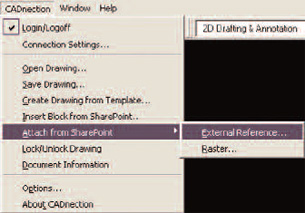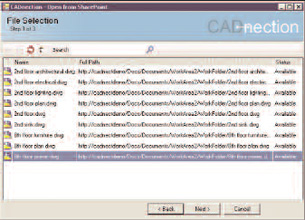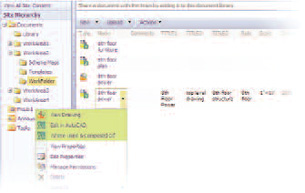Latest News
September 29, 2008
By Richard W. Bourke
 Figure 1: CADnection provides the drawing management functions on the new pull-down menuon an AutoCAD screen. |
Ensuring effective product development is a constant challenge for companies whose integration of best practices, processes, and software tools is inadequate. The drawbacks include increased time and costs of product development and compromised product quality. These results are unacceptable in today’s highly competitive environment.
However, if you’re an AutoCAD user working for a company where Microsoft’s SharePoint is available — help is here. CADnection recently announced a software product by the same name that seamlessly integrates AutoCAD with SharePoint, extending the functionality of both software tools.
Autodesk’s AutoCAD includes the company’s free Vault software for drawing storage. SharePoint is a content-management suite for managing data file storage, collaboration, search, revision control, and workflow process control. With more than 100 million users, SharePoint is rapidly becoming recognized as a foundation to support many business activities, of which product development can be a primary candidate.
According to CADnection’s marketing literature, the easy-to-use integration of AutoCAD and SharePoint helps users achieve the operational benefits of increased productivity and improved product quality, as well as the strategic benefit of reduced time to market. This review’s aim is to validate the stated capabilities of the CADnection software and to determine whether these capabilities substantiate its claimed benefits.
 Figure 2: A CADnection screen activates the search capabilities of SharePoint |
A Frame of Reference
Before we discover a fresh approach to AutoCAD drawing management — using CADnection — consider that both AutoCAD and SharePoint have strengths, but each has some limitations. Bear in mind also that the design intent of CADnection is to build on the strengths of each while overcoming their limitations.
To gain productivity in product development, an essential need during design activity is complete visibility into all levels of two drawing relationships: drawing tree (top-down) and where-used (in other words, a drawing-centric approach). A drawing might represent a part, an assembly, or an entire plant. This visibility is vital for many design analyses, and for pending changes or design reuse, all aimed at reducing costs and improving product quality.
AutoCAD is drawing-centric. A key strength is its reference file (XREF) function, which provides the ability to logically attach other AutoCAD drawings and raster images, as children of the parent drawing, or as blocks in a drawing. When a designer defines these relationships, AutoCAD automatically incorporates any changes to child drawings into the parent drawing. This drawing tree view (top-down) is visible in the File References panel on an AutoCAD screen. But, AutoCAD does not maintain and show the other essential drawing relationships such as where-used information.
SharePoint, in contrast, is document-centric; it manages files of any format, including drawings. As mentioned earlier, among its capabilities are sharing, collaboration, search, revision control, and workflow process control. However, it cannot show either of the two drawing relationships required for effective product development.
 Figure 3: The enhanced SharePoint Documents screen identifies the new CADnection functions. |
The good news: CADnection integrates AutoCAD and SharePoint to provide the enhanced functionality for supporting both drawing tree and where-used relationships. This is accomplished by extending the XREF capabilities of AutoCAD. CADnection also takes full advantage of SharePoint as a data and file repository for drawings and related reference files; they are treated as any other file. Moreover, the multi-site capabilities of SharePoint can be leveraged with AutoCAD for design collaboration and review of drawings, using the new viewing options provided by CADnection.
Drawing Management Using CADnection
Now we can explore CADnection’s capabilities to manage AutoCAD drawings. In the following screen shots, you can see that CADnection has created new icons and tabs. They allow users to seamlessly use functions from both AutoCAD and SharePoint. As shown in Figure 1, the additional CADnection tab on the AutoCAD tool bar lists the drawing management functions now available and are used to access them.
A typical day of activity starts with designers either working on an existing drawing or creating a new one by using the CADnection functions of Open Drawing or Create Drawing from Template. Wizards guide users through the steps providing options for data integrity, such as whether to open all related drawings (drawing tree), to select the right version, or whether to lock or unlock a drawing.
Before creating a new drawing, a designer might prepare by doing some research to avoid accidentally duplicating previous design efforts. To facilitate this action, a CADnection enhancement activates the search capabilities of SharePoint to retrieve drawings based on title block metadata, as shown in Figure 2. Moreover, text information on drawings can also be retrieved by selected search criteria. Text information may contain valuable information that otherwise would be difficult, if not impossible, to retrieve. One example might be notes about applicable specifications on the drawings.
|
During design activity, the AutoCAD user can take advantage of existing drawing data stored in SharePoint by using these CADnection functions: Insert Block from SharePoint and/or Attach from SharePoint, as seen in Figure 1. The Attach function creates the XREF information that appears in the File References panel of AutoCAD.
Before closing out design activity, the user has the option of creating a DWF file, Autodesk’s Design Web Format, a lightweight format that permits casual users to view a drawing, without requiring AutoCAD. As the native Autodesk DWG format is stored, the user can also store the DWF for later use in drawing reviews.
For checking-in the drawing, CADnection provides the function Save Drawing to SharePoint. At this time, CADnection automatically rebuilds the drawing relationships and maps the attributes in the drawing title block to the properties of SharePoint.
This key function assures all AutoCAD users that the metadata of the drawing title block is properly synchronized with SharePoint data — another step to data integrity. Put another way, users will more likely trust the system. Once the drawings are saved, the up-to-date drawings are then available to all SharePoint users.
Using SharePoint withCADnection Enhancements
On the SharePoint Document screen, a user will quickly see, and be able to use, the enhancements shown in Figure 3. CADnection has modified this screen to show the primary metadata elements of a drawing’s title block.
In addition, the pull-down menu associated with a selected drawing provides these new CADnection functions:
View Drawing — allows users a choice of file formats. Of particular interest is the DWF file. Autodesk’s Design Review software, offered free, is built on the DWF file format. It allows dispersed team members to view, print, mark up, and suggest revisions to the responsible designers.
Edit in AutoCAD — allows the users to directly access AutoCAD drawings.
Where Used & Composed Of — gives users immediate viewing of these two drawing relationships, as shown in Figure 4 above.
Using Design Review, with SharePoint capabilities, facilitates multi-site collaboration and workflow processing — vital for many companies in this time of dispersed design teams within a company and outsourced design and manufacturing throughout the global supply chain. Moreover, companies should rightfully expect considerable savings in time and expense of project reviews.
As with most software tools, global settings allow customizing the CADnection installation to an individual company’s choices. Clicking the Options selection on the CADnection tab, shown in Figure 1, brings up choices for Work Space, Preferences regarding Check-in/Check-out standards and Attribute Mapping. Before daily use of CADnection, it will be essential to define access controls and security provisions, as well as identify all Vault locations where AutoCAD files will be stored to gain additional data integrity.
Justification and Implementation
Justification for CADnection means weighing the equation of expected benefits versus the estimated costs. In my opinion, using CADnection helps users gain the business objectives claimed in CADnection’s marketing literature. Contributing to this assertion is my observation that the company’s claim as to its being easy to use is well founded.
On the cost side of the equation, CADnection is currently priced at $6,995 for a bundle of 25 seats, plus a yearly maintenance fee of 18 percent of the purchase price to provide ongoing CADnection updates. Of course, this equation assumes that AutoCAD and SharePoint are already in place.
What’s more, the prospective buyer must consider that CADnection was not designed to support bulk loading. Therefore, implementation planning and budgeting must account for any required processes for data extraction, drawing transformation, and loading of data. For example, the transformation process may require DWG to DWF creation, and the loading process may need to indicate any file duplication for correction.
Accordingly, extra costs for implementation and deployment support are quoted on an individual company basis. Since the User Guide and help screens are not yet complete, perhaps a few hours of CADnection training might be needed. Because I only tested the installed sample database, I cannot comment on the ease and costs of installation.
Using CADnection software to integrate AutoCAD with the extensive capabilities of SharePoint will be very attractive to many companies. The additional investment in CADnection software, and perhaps some implementation support, should be minimal — with a fast payoff.
More Info:
Autodesk
San Rafael,CA
autodesk.com
CADnection, Inc.
Orange, CA
cadnection.com
Microsoft
Redmond,WA
microsoft.com
For more information on PLM, go to deskeng.com.
Richard W. Bourke provides PLM, configurability, and ERP consulting to manufacturing companies and software firms. He has contributed to Desktop Engineering in the past. Visit his website at bourkeconsulting.com. Please send comments to [email protected].
Subscribe to our FREE magazine, FREE email newsletters or both!
Latest News
About the Author
DE’s editors contribute news and new product announcements to Digital Engineering.
Press releases may be sent to them via [email protected].







